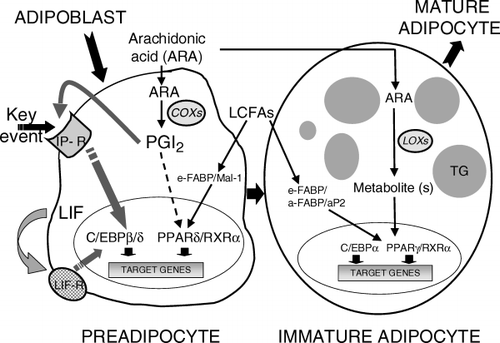Figures & data
Fig. 1. Redundant pathways and long-chain fatty acids (LCFAs) implicated in adipogenesis. At least two cell-surface receptor/ligand systems concur to up-regulate the expression of CCAAT/enhancer binding protein-β (C/EBPβ) and C/EBPΔ [i.e. prostacyclin receptor (IP)/prostacyclin, and leukaemia inhibitor factor (LIF) receptor/LIF, and to promote adipogenesis. In preadipocytes, arachidonic acid (ARA) favours the synthesis of prostacyclin, which is then released. Thus, ARA via prostacyclin triggers a key event, plays a unique role in activating the protein kinase A pathway by means of IP, and enhances the differentiation process. Furthermore, prostacyclin is assumed to bind to peroxisome proliferator activated receptor-β/Δ (PPARβ/Δ). Other dietary LCFAs act as activators/ligands of PPARβ/Δ and PPARγ. Upon terminal differentiation, LIF is no longer produced. Production of prostacyclin and other prostaglandins ceases and is accompanied by reduced expression and loss of functional IP. In addition to ARA metabolites synthesized through cyclooxygenases (COXs) at early step(s), ARA metabolites synthesized through lipoxygenases (LOXs) as ligands of PPARγ are also implicated at later step(s). Epidermal (keratinocyte) fatty acid binding protein (e-FABP/Mal1) in preadipocytes and also adipocyte fatty acid binding protein (a-FABP/aP2) in adipocytes are assumed to bind and transport LCFAs. TG: triglycerides.
